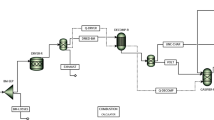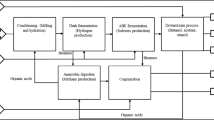Abstract
Purpose
Coffee cut-stems (CCS) are typically left in the field after coffee harvesting as fertilizer or used partially for cooking and drying of coffee grains. However, the energy contained in this residue is not completely exploited. For this reason, different applications for CCS have been considered to obtain innovative products. This work aims to evaluate the environmental impact of energy generation through two biorefinery systems using CCS as feedstock.
Methods
The life cycle assessment (LCA) considers a cradle-to-gate approach, beginning at the seed germination and ending at the production of ethanol, electricity, and low-pressure steam. Inventory data of the coffee production are collected from national reports. Mass and energy balances are calculated using an integrated methodological approach comprising the conceptual design and optimization of the CCS biorefineries.
Results and discussion
CCS production is one of the hotspots in both evaluated biorefineries due to the use of high amounts of fertilizers, contributing to most of the environmental impact categories. From the two assessed biorefinery configurations, the system with the lowest environmental benefits was the one that considered the generation of electricity and steam. Factors such as the high emissions of exhaust gases (mainly composed of CO2) and the use of water for steam generation were the main contributors. The alternative solution I (AS-I) has the lowest environmental impact in comparison with the base case. From the sensitivity analyses, the use of energy allocation approach provided better performance than the system expansion approach. However, the selection of one approach over the other highly depends on the evaluated impact category based on the uncertainty analysis.
Conclusions
The production of CCS has the highest contribution to the overall environmental impact of the evaluated biorefineries, and thus, we need available information of the coffee crop production including the production of co-products, such as CCS. We present a detailed inventory of the production of CCS in Colombia as an important contribution for further research in the area of coffee-based biorefineries. Based on our inventory, the production of bioenergy (electricity and steam) for a coffee-based biorefinery seems to provide the best environmental performance in comparison to the production of biofuels (ethanol).









Similar content being viewed by others
References
Althaus H, Hischier R, Osses M et al (2007) Life cycle inventories of chemicals. Ecoinvent Rep No 8(v20):1–957
Arcila PJ, Farfán VF, Moreno BA et al (2010) Capítulo 4. Establecimiento del cafetal. In, Sistemas de producción de café en Colombia, pp 87–100
Aristizábal-Marulanda V, Cardona ACA, Martín M (2019) An integral methodological approach for biorefineries design: Study case of Colombian coffee cut-stems. Comput Chem Eng 126:35–53
Marulanda VA (2015) Jet biofuel production from agroindustrial wastes through furfural platform. Universidad Nacional de Colombia. Departamento de Ingeniería Química. Master Thesis
Balat M, Balat M, Kırtay E, Balat H (2009) Main routes for the thermo-conversion of biomass into fuels and chemicals. Part 2: Gasification systems. Energy Convers Manag 50:3158–3168. https://doi.org/10.1016/j.enconman.2009.08.013
Barrera-Ramírez J, Prado V, Solheim H (2019) Life cycle assessment and socioeconomic evaluation of the illicit crop substitution policy in Colombia. J Ind Ecol 1–16 https://doi.org/10.1111/jiec.12917
Brommer E, Stratmann B, Quack D (2011) Environmental impacts of different methods of coffee preparation. Int J Consum Stud 35:212–220. https://doi.org/10.1111/j.1470-6431.2010.00971.x
Castro-Toro AM, Rivillas-Osorio CA, Serna-Giraldo CA, Mejía-Mejía CG (2008) Avances técnicos 368 Cenicafé. Construcción, manejo de Rhizoctonia solani y costos, Germinadores de café
Catalán E, Komilis D, Sánchez A (2019) Environmental impact of cellulase production from coffee husks by solid-state fermentation: A life-cycle assessment. J Clean Prod 233:954–962. https://doi.org/10.1016/j.jclepro.2019.06.100
Centro Nacional de Investigaciones del Café (Cenicafé) (2004) Cartilla cafetera 4. Germinadores y almácigos de café
Centro Nacional de Investigaciones del Café (Cenicafé) (2016) Cultivemos café/Sistemas de producción. https://www.cenicafe.org/es/index.php/cultivemos_cafe/sistemas_de_produccion/cultivemos_cafe_libro_sistemas_de_produccion_de_cafe_establecimiento_del_ca Accessed June 2018
Chaudhary A, Verones F, De Baan L et al (2016) Chapter 11: Land stress: Potential species loss from land use (global; PSSRg). In: LC-Impact version 0.5. pp 90–101
Cherubini E, Franco D, Zanghelini GM, Soares SR (2018) Uncertainty in LCA case study due to allocation approaches and life cycle impact assessment methods. Int J Life Cycle Assess 23:2055–2070. https://doi.org/10.1007/s11367-017-1432-6
Cherubini F, Strømman AH, Ulgiati S (2011) Influence of allocation methods on the environmental performance of biorefinery products—a case study. Resour Conserv Recycl 55:1070–1077. https://doi.org/10.1016/j.resconrec.2011.06.001
Dalgaard R, Halberg N, Hermansen JE (2007) Danish pork production: An environmental assessment 82:1–38
Departamento Administrativo Nacional de Estadísticas (DANE) (2017) Producto Interno Bruto en Colombia - Tercer Trimestre de 2017. In: www.dane.gov.co
Djekic I, Pojić M, Tonda A et al (2019) Scientific challenges in performing life-cycle assessment in the food supply chain. Foods 8. https://doi.org/10.3390/foods8080301
Farfán-Valencia F (1994) Avances técnicos 209. El zoqueo del café conserva el bosque nativo
Federación Nacional de Cafeteros de Colombia (2019) Economía Institucional del Café. In: Sobre café. Mucho más que una bebida. http://www.cafedecolombia.com/particulares/es/sobre_el_cafe/mucho_mas_que_una_bebida/economia_institucional_del_cafe/ Accessed: September 2019
Gaitan BAL, Villegas GC, Rivillas OCA et al (2011) Avances técnicos 404. Almacigos de cafe: Calidad fitosanitaria, manejo y siembra en el campo
Garcia CA, Hora G (2017) State-of-the-art of waste wood supply chain in Germany and selected European countries. Waste Manag 70:189–197. https://doi.org/10.1016/j.wasman.2017.09.025
García CA, Moncada J, Aristizábal V, Cardona CA (2017) Techno-economic and energetic assessment of hydrogen production through gasification in the Colombian context: Coffee cut-stems case. Int J Hydrogen Energy 42:5849–5864. https://doi.org/10.1016/j.ijhydene.2017.01.073
García Velásquez CA (2016) Hydrogen production through gasification and dark fermentation. Universidad Nacional de Colombia. Departamento de Ingeniería Química. Master Thesis
González-García S, Moreira MT, Dias AC, Mola-Yudego B (2014) Cradle-to-gate life cycle assessment of forest operations in Europe: Environmental and energy profiles. J Clean Prod 66:188–198. https://doi.org/10.1016/j.jclepro.2013.11.067
Harris S, Narayanaswamy V (2009) A Literature Review of Life Cycle Assessment in Agriculture
Hassard HA, Couch MH, Techa-erawan T, McLellan BC (2014) Product carbon footprint and energy analysis of alternative coffee products in Japan. J Clean Prod 73:310–321. https://doi.org/10.1016/j.jclepro.2014.02.006
Stranddorf HK, Hoffmann L, Schmidt A (2005) Impact categories, normalisation and weighting in LCA. Environ News 78:1–90. Environmental project nr. 995
Heijungs R, Huijbregts MAJ (2004) A review of approaches to treat uncertainty in LCA. iEMSs 2004 Int Congr 8. http://www.iemss.org/iemss2004/pdf/lca/heijarev.pdf
Huijbregts MAJ (1998) Application of uncertainty and variability in LCA. Part I: A general framework for the analysis of uncertainty and variability in life cycle assessment. Int J Life Cycle Assess 3:273–280. https://doi.org/10.1007/BF02979835
Humbert S, Loerincik Y, Rossi V et al (2009) Life cycle assessment of spray dried soluble coffee and comparison with alternatives (drip filter and capsule espresso). J Clean Prod 17:1351–1358. https://doi.org/10.1016/j.jclepro.2009.04.011
IDEAM, PNUD, MADS, et al (2016) Inventario Nacional Y Departamental De Gases Efecto Invernadero - Colombia. Tercera. Bogotá D.C, Colombia
International Coffee Organization (ICO) (2019) Total production by all exporting countries 2015–2018
International Energy Agency IEA (2017) Producing ammonia and fertilizers: New opportunities from renewables
Jacquemin L, Pontalier PY, Sablayrolles C (2012) Life cycle assessment (LCA) applied to the process industry: A review. Int J Life Cycle Assess 17:1028–1041. https://doi.org/10.1007/s11367-012-0432-9
Kookos IK (2018) Technoeconomic and environmental assessment of a process for biodiesel production from spent coffee grounds (SCGs). Resour Conserv Recycl 134:156–164. https://doi.org/10.1016/j.resconrec.2018.02.002
Lelek L, Kulczycka J, Lewandowska A, Zarebska J (2016) Life cycle assessment of energy generation in Poland. Int J Life Cycle Assess 21:1–14. https://doi.org/10.1007/s11367-015-0979-3
Maga D, Thonemann N, Hiebel M et al (2019) Comparative life cycle assessment of first- and second-generation ethanol from sugarcane in Brazil. Int J Life Cycle Assess 24:266–280. https://doi.org/10.1007/s11367-018-1505-1
May B, England JR, Raison RJ, Paul KI (2012) Cradle-to-gate inventory of wood production from Australian softwood plantations and native hardwood forests: Embodied energy, water use and other inputs. For Ecol Manage 264:37–50. https://doi.org/10.1016/j.foreco.2011.09.016
de Melo FM, Silvestre A, Carvalho M (2019) Carbon footprint associated with electricity generation from biomass, syngas and diesel. Environ Eng Manag J 18:1391–1397
Mendoza Beltran A, Heijungs R, Guinée J, Tukker A (2016) A pseudo-statistical approach to treat choice uncertainty: The example of partitioning allocation methods. Int J Life Cycle Assess 21:252–264. https://doi.org/10.1007/s11367-015-0994-4
Muñoz I, Flury K, Jungbluth N et al (2014) Life cycle assessment of bio-based ethanol produced from different agricultural feedstocks. Int J Life Cycle Assess 19:109–119. https://doi.org/10.1007/s11367-013-0613-1
National Coffee Research Center (2015) Cenicafé generates electricity from coffee tree wood. https://www.federaciondecafeteros.org/algrano-fnc-en/index.php/comments/cenicafe_generates_electricity_from_coffee_tree_wood/. Accessed May 2018
Nemecek T, Kägi T (2007) Life Cycle Inventories of Agricultural Production Systems. ecoinvent Rep No 15 20:1–360
Nufarm (2010) Datasheet Mancozeb 80% WP
Pitt WW, Haag GL, Lee DD (1983) Recovery of ethanol from fermentation broths using selective sorption-desorption. Biotechnol Bioeng 25:123–131
Product Sustainability Forum (2013) Hotspots, opportunities & initiatives. Coffee. Improv Environ Perform Prod 1–30
Quintero Suárez JA (2011) Design and Evaluation of Fuel Alcohol Production from Lignocellulosic Raw Materials. Universidad Nacional de Colombia. Departamento de Ingeniería Eléctrica, Electrónica y Computación. Ph.D. Thesis
Raynolds M, Checkel MD, Fraser RA (1999) Application of Monte Carlo analysis to life cycle assessment. SAE Trans 108:1–9
Razak AMY (2007) Industrial Gas Turbines: Performance and Operability
Dinero R (2017) Rentabilidad de la caficultura es del 25%: Federación de Cafeteros. https://www.dinero.com/Item/ArticleAsync/253186?nextId=253178. Accessed June 2018
Rincón LE, Becerra LA, Moncada J, Cardona CA (2014) Techno-economic analysis of the use of fired cogeneration systems based on sugar cane bagasse in south eastern and mid-western regions of Mexico. Waste and Biomass Valorization 5:189–198. https://doi.org/10.1007/s12649-013-9224-0
Rodríguez Valencia N, Zambrano Franco D (2010) Avance técnico 393. Los subproductos del café: Fuente de energía renovable. Av Técnicos Cenicafé 8. ISSN-0120–0178
Rossier D, Charles R (1998) Ecobilan: Adaptation de la méthode écobilan pour la gestion environnementale de l’exploitation agricole
Sadeghian S (2008) Guía práctica: Fertilidad del suelo y nutrición del café en Colombia. Boletín técnico No. 32
Sadeghian Khalajabadi S, González Osorio H (2012) Avances técnicos 424. Alternativas generales de fertilización para cafetales en la etapa de producción
Salomone R (2003) Life cycle assessment applied to coffee production: Investigating environmental impacts to aid decision making for improvements at company level. Food, Agric Environ 1:295–300
Segura-Salazar J, Lima FM, Tavares LM (2019) Life Cycle Assessment in the minerals industry: Current practice, harmonization efforts, and potential improvement through the integration with process simulation. J Clean Prod 232:174–192. https://doi.org/10.1016/j.jclepro.2019.05.318
Segura MA, Andrade HJ (2012) Huella de carbono en cadenas productivas de café (Coffea arabica L.) con diferentes estándares de certificación en Costa Rica. Luna Azul 60–77. https://doi.org/10.17151/luaz.2012.35.5
Sepp J, Melanen M, Jouttij T et al (1998) Forest industry and the environment : A life cycle assessment study from Finland. Resour Conserv Recycl 23:87–105
Sharma AK (2011) Modeling and simulation of a downdraft biomass gasifier 1. Model development and validation. Energy Convers Manag 52:1386–1396. https://doi.org/10.1016/j.enconman.2010.10.001
Teillard F, Maia de Souza D, Thoma G et al (2016) What does Life-cycle assessment of agricultural products need for more meaningful inclusion of biodiversity? J Appl Ecol 53:1422–1429. https://doi.org/10.1111/1365-2664.12683
The Fertilizer Institute (2016) State of the Fertilizer Industry - Environment and Energy. In: Reduce, Reuse, Sustain. https://www.tfi.org/our-industry/state-of-industry/environment-energy. Accessed August 2018
Tuntiwiwattanapun N, Usapein P, Tongcumpou C (2017) The energy usage and environmental impact assessment of spent coffee grounds biodiesel production by an in-situ transesterification process. Energy Sustain Dev 40:50–58. https://doi.org/10.1016/j.esd.2017.07.002
Turconi R, Boldrin A, Astrup T (2013) Life cycle assessment (LCA) of electricity generation technologies: Overview, comparability and limitations. Renew Sustain Energy Rev 28:555–565. https://doi.org/10.1016/j.rser.2013.08.013
Valencia NR (2000) Manejo de residuos en la agroindustria cafetera
Van Zelm R, Preiss P, Van Dingenen R, Huijbregts M (2016) Chapter 6: Particulate Matter Formation. In: LC-Impact version 0.5. pp 52–60
Acknowledgments
The authors express their acknowledgments to Departamento Administrativo de Ciencia, Tecnología e Innovación (Colciencias) call 727 of 2015.
Author information
Authors and Affiliations
Corresponding author
Additional information
Communicated by Nydia Suppen-Reynaga.
Publisher’s Note
Springer Nature remains neutral with regard to jurisdictional claims in published maps and institutional affiliations.
Supplementary Information
Below is the link to the electronic supplementary material.
Rights and permissions
About this article
Cite this article
Aristizábal-Marulanda, V., García-Velásquez, C.A. & Cardona Alzate, C.A. Environmental assessment of energy-driven biorefineries: the case of the coffee cut-stems (CCS) in Colombia. Int J Life Cycle Assess 26, 290–310 (2021). https://doi.org/10.1007/s11367-020-01855-0
Received:
Accepted:
Published:
Issue Date:
DOI: https://doi.org/10.1007/s11367-020-01855-0




